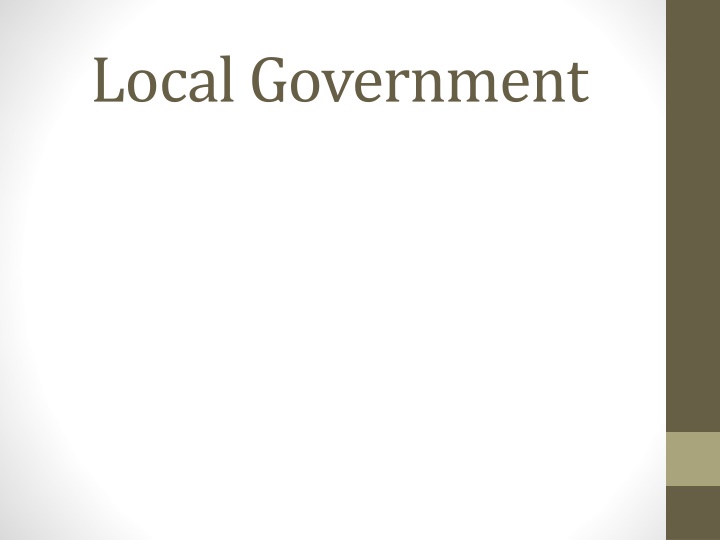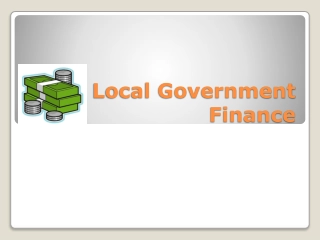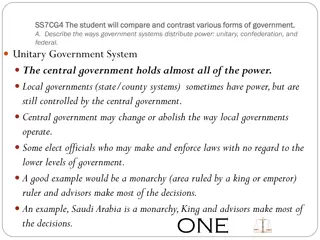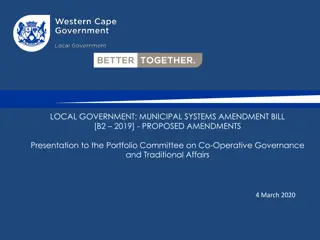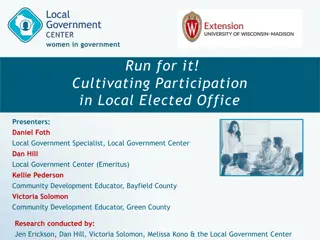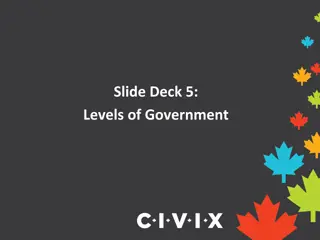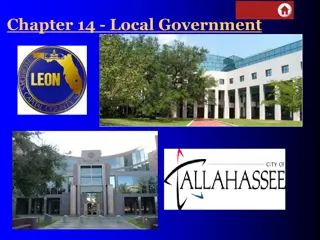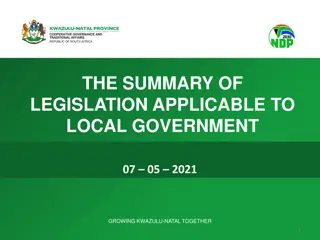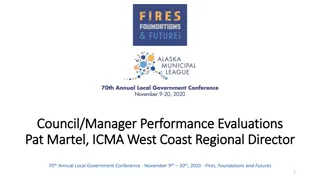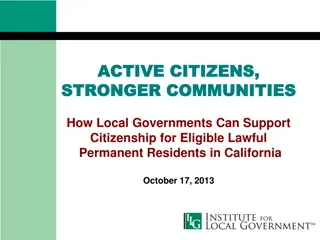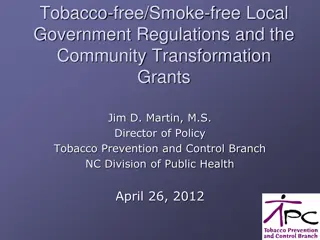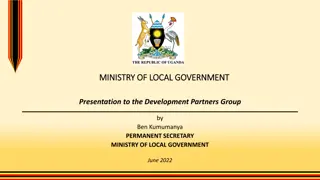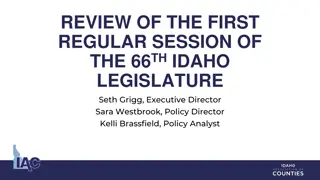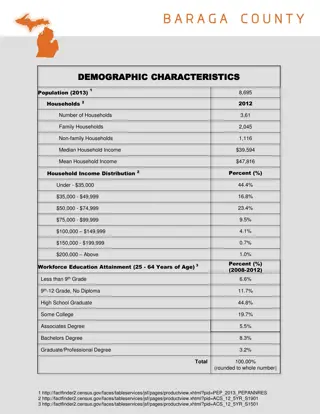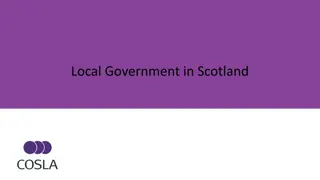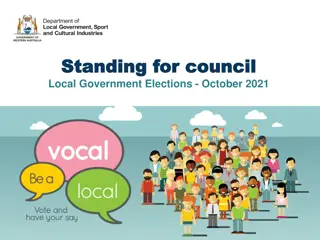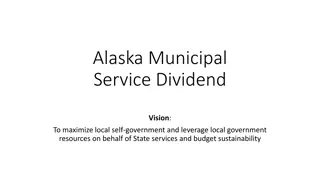Local Government Structures
Local governments in the United States, including counties and cities, play a crucial role in implementing and enforcing laws. Counties serve rural areas and perform various duties such as law enforcement, tax assessment, road maintenance, and school management. Despite their importance, county governments often face challenges such as poor organization, inexperienced officials, and geographic limitations that necessitate reform.
Download Presentation

Please find below an Image/Link to download the presentation.
The content on the website is provided AS IS for your information and personal use only. It may not be sold, licensed, or shared on other websites without obtaining consent from the author.If you encounter any issues during the download, it is possible that the publisher has removed the file from their server.
You are allowed to download the files provided on this website for personal or commercial use, subject to the condition that they are used lawfully. All files are the property of their respective owners.
The content on the website is provided AS IS for your information and personal use only. It may not be sold, licensed, or shared on other websites without obtaining consent from the author.
E N D
Presentation Transcript
Do Now: 1/2/20 What is the lowest level of government in Yonkers, NY?
Local Government In 2007 the U.S. Census counted 89,247 local governments. Local governments include counties, cities, towns, townships, school districts, and other special districts. The U.S. Constitution says nothing about local governments. The States have the sole right to create and abolish local governments within their borders. Local governments have only the authority granted to them by the State government.
Counties There are 3,033 counties in the United States. Counties vary greatly in physical size and Population. The number of counties per State varies. In Alaska, counties are called boroughs. In Louisiana they are parishes. Connecticut, Rhode Island, and some other areas have no counties.
County Structure Each county has a governing body. Names for this body vary, though county board is common. Board members are elected from county districts, usually for four year terms. Boards of commissioners have 3 to 5 members, while less common boards of supervisors average about 15 members.
County Structure All county boards levy taxes, borrow money, and pass local laws. They also hire county employees, supervise road programs, and manage county property.
County Functions Counties carry out State and county laws. Most counties serve rural areas. Common county duties include law enforcement, tax assessment, tax collection, building and repairing roads, and maintaining schools. More heavily populated counties provide many of the same services offered by city governments.
Problems with County Govt Why do most county governments need reform? Poor organization: Authority is divided among many independent, popularly elected boards and officials. Inexperienced officials: Popularly elected officers may have little governing experience. Geographic problems: Most counties are geographically ill-suited to the realities of the modern world.
Reforms County government reforms include: Allowing county home rule, so individual counties can organize their own governments in a way that more efficiently meets their needs. Hiring professional county managers to act as chief administrators for counties. Combining large cities and the counties that surround them into single units of government to consolidate resources.
How do city governments serve the needs of residents and other Americans? Cities provide a wide range of public services to their residents. Cities also plan for their own growth and development through zoning laws. They do so by setting policies using various forms of city government to divide executive and legislative power.
Do Now: 1/3/20 How many counties are there in the United States?
How are cities established? Each State constitution sets out its own rules of incorporation. This usually requires that a minimum number of people live within a given area and that they request to become a city. Each city creates a charter that names the city, sets its boundaries, creates its legal identity, and describes its powers and the structure of its government.
Mayor-Council Form The mayor-council government is the most common form of city government. It features a mayor as the chief executive and an elected council as the legislative body. Its disadvantages are that it requires a good mayor, can be stalled by a mayor-council dispute, and can be hard for citizens to understand. The city council usually has from five to nine members, each elected from a city district to a four-year term.
Mayors Voters usually elect the mayor. Mayors preside at council meetings and recommend legislation. Mayor-council governments are often described as strong- mayor or weak-mayor.
City Planning Early cities grew without any plan for development. Now most cities have formed planning agencies to correct past mistakes and guide future growth. Most federal grant and loan programs require cities to have development plans.
What is the purpose of zoning? Zoning ordinances set certain areas in cities aside for specific uses to aid in city planning. Common zones are industrial, residential, and commercial. Zoning laws also set limits on the size and type of buildings in an area. Zoning laws can put limits on a person s use of their property, but must be reasonable in doing so.
Municipal Functions Cities provide many different public services for their residents. They offer police and fire protection. They build and maintain streets, side- walks, libraries, bridges, hospitals, libraries, parks, schools, public housing projects, and so forth. They also operate water, gas, electrical, sanitation, sewer, garbage collection, public health, and transportation systems.
Do Now: 1/6/20 What are mayor-council forms of government often described as?
Suburbs The suburban boom began after World War II. Today, about half of all Americans live in suburbs. People moved to suburbs for more room, cheaper land, better schools, lower taxes, and less crime. Businesses and industries also followed this population shift. The move to the suburbs has taken financial and social resources away from city centers.
Metropolitan Areas As cities have grown, they have taken control of outlying areas. Some cities create special districts. Oregon s Metro agency handles transportation planning in and around the city of Portland. In some cases, counties have begun providing expanded services.
What services do State and local governments provide? State and local governments provide public education and welfare assistance, build and maintain roads and highways, and protect public health and safety. Authorities deliver these services directly through State agencies and through the many forms of local government in each State.
Education Public education is the most expensive item in every State budget. Example: Yonkers Public Schools 2018-2019 Budget Total: $615,616,354 Funding and spending per public school student has increased greatly in the past 25 years. Every State also funds a public higher education system.
What are a States responsibilities for education? The level of State funding for primary and secondary education varies from State to State. Most funding comes from local property taxes. States set legal guidelines for teacher qualifications, curricula, content standards, educational materials, statewide skills tests, and the length of the school year.
Do Now: 1/7/20 What is a suburb?
Public Welfare States pass laws, conduct inspections, and issue licenses to protect the public welfare. Most States have public health programs. States operate public hospitals, immunize children, and help run medical assistance programs for the poor, such as Medicaid. States also provide welfare benefits. From 1936 to 1996, States shared the cost of the Aid to Families with Dependent Children welfare program with the federal government.
Public Welfare In 1996, the Federal government began the Temporary Assistance to Needy Families (TANF) program. Under TANF, each State receives a fixed amount of money each year to spend on welfare benefits. No one can receive more than five years of benefits and recipients must work or take part in vocational training or community service. The number of people on welfare has dropped, but States face a challenge helping those who remain.
Public Safety Each State has a variety of police forces that preserve law and order. State police patrol roads and highways. In rural areas, they may be the primary police force or provide key support to local law-enforcement agencies. Each State also operates corrections facilities, which hold convicted criminals. More than 2.5 million people are in jail, more than half in State prisons.
Highways The federal government shares the cost of major highway projects, such as Boston s Big Dig, with the States. The largely federal funded Interstate Highway System began in 1956 and is nearing completion today.
Highways The interstate highway system makes up only some 45,000 miles of more than 4 million miles of American roads. Many roads are built and maintained with State funds. State and local governments also ensure public safety on the roads. They license drivers, patrol the roads, set speed limits, and inspect vehicles.
Do Now: 1/8/20 How are roads built and maintained?
How do State governments raise money to pay for services? State governments use a variety of taxes, particularly income and sales taxes, to raise revenue. States also operate public enterprises, charge licensing, operating, and usage fees, run lotteries, and issue bonds. States also receive federal grants.
Limits on Taxation Constitutional limits on State taxes: States cannot tax interstate and foreign trade. The 14th Amendment requires taxes to be applied fairly regardless of race, religion, or other factors. Taxes cannot be unreasonably heavy and must be used only for public purposes. State constitutions also limit maximum tax rates and the taxing power of local governments.
Principles of Taxation Adam Smith outlined four basic principles of a fair tax system: Everyone should contribute a fair share of taxes, proportional to their income. Taxes should not be arbitrary. Every tax should be levied in a time and fashion that is convenient for the person paying it. Every tax should cost the people as little as possible while paying for government expenses.
Sales Tax Sales taxes account for the largest portion of State tax revenue. Some 45 States levy a sales tax, usually of 5 or 6 percent. A general sales tax applies to most goods. A selective sales tax is levied on only certain goods.
Sales Tax All States impose a selective sales tax on some items. These include things like gas, cigarettes, and alcohol. Sales taxes are regressive, falling most heavily on those least able to pay. States cannot tax most Internet purchases. Many States complain that this ban costs them needed revenue.
Income Tax Taxes on the incomes of individuals and corporations provides a third of State tax revenue. Some 43 States have a personal income tax. Individual income State tax rates are progressive the higher the income, the more tax is paid. These rates ranges from 2 to 9 percent. Corporate income tax rates are usually fixed.
Do Now:11/30/18 Explain how income tax is progressive.
Property Taxes Property taxes are levied mainly by local governments. They provide about three- fourths of all local government income. Real property includes land and buildings.
Property Taxes Personal property includes tangible property (such as computers, cars, and books) and intangible property (stocks, bonds, mortgages, and bank accounts). Local officials assess the value of property to be taxed. Critics claim that it is hard to assess fair values for all property. Supporters argue that government both protects property and increases its value, and so has a right to tax it.
Other Taxes Every State has some form of estate or inheritance tax. Most States use a variety of business taxes beyond corporate income tax. States tax the removal of natural resources such as timber, oil, and ore. States require various business and occupational licenses for businesses to operate. States also use payroll taxes and require licenses for drivers and motor vehicles.
Other Sources of Income States receive large amounts of federal grant money. Some 42 States run lotteries. State and local governments also make money from public enterprises. These include ferries, toll roads and bridges, and State-owned liquor stores. Many cities run their own water, electricity, and bus systems. Users must pay fees for public services such as hospitals, airports, parks, sewers, and garbage disposal.
Borrowing How and why do State and local governments borrow money? States and local governments often issue bonds to borrow money for major projects. Most State constitutions put strict limits on how much governments can borrow. States debts total about $900 billion. Local governments owe more than a trillion dollars.
State Budgets A budget is both a financial and political plan in which the State sets its spending priorities. The State budget process was once poorly organized. All but three States now use the executive budget. This gives the governor the power to prepare the State budget and to manage the spending of funds.
Budget Process The budget process typically works as follows: Each agency prepares budget estimates. These are reviewed and revised, then combined into a State budget that the governor presents to the legislature.
Budget Process The legislature decides what parts of the budget to approve or expand, passing revenue measures as needed. The governor supervises the spending of funds, subject to an independent check of spending practices called a post audit.
